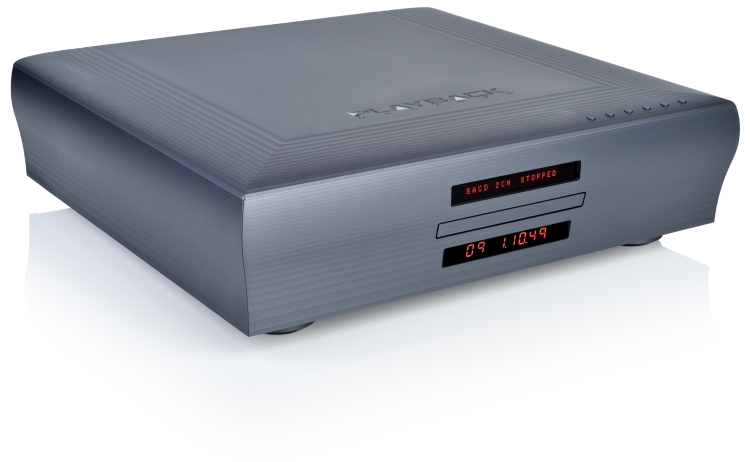Naim NDX, CDX2, DAC and XPS2
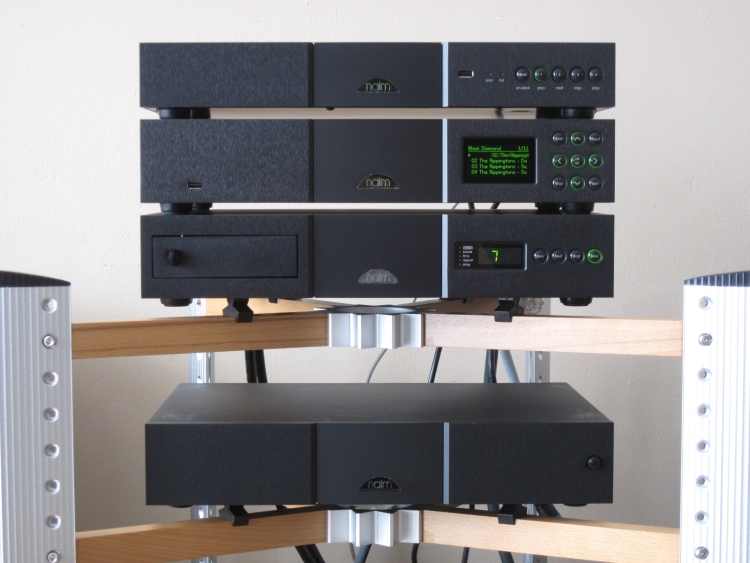
After being so enthusiastic about the UnitiQute and Uniti, I was curious to find out how much more there would be in the Naims higher up on the scale
The result is a review dedicated to no less than four Naim components: CD Player/Streamer/DAC/PS.
Simultaneously, I’m still investigating whether or not streaming can really substitute CD replay. The CD player and streamer in this Naim stack are similarly priced and should represent a fair comparison to assess this. To top it off there’s the universal XPS power supply that can power either of the components, one at a time, and the DAC, which is a standalone, well, DAC.
Setup
Right after receiving the units, I’ve set them up, so that they could acclimatise, and left the whole stack powered on for a few days. While lifting the components it’s amazing how heavy they are: Naim’s focus is on big linear power supplies and it really shows!
When reviewing so many items at the same time, there’s the chance of running into problems with power and placement. Sure I’ve got enough power outlets and definitely enough power cables, as well as plenty of rack space. But I’ve noticed many a time that you have to be careful with setup and that you shouldn’t connect too many components at once, all with fat sounding powercables. What will happen is that it all will sound much fatter than when only one of those components is connected at a time, or to use fat sounding power cables only on the components under test and simple (packed-in) powercables on the other components to keep them powered up. I soon found out that the Naim components don’t really like fat sounding power cables and they have a hang for simpler, straight-sounding cables such as Belden or even the cables that come packed in with the component when you buy it. The latter make the Naims sound thinner and less colorful than they can do but they will sound nice and open, and very enthusiastic. Not so much with Lapp cables, which lends a nice smooth and full tonality, but also takes away a lot of PRAT, dynamics and even some resolution. This is not to say that big power supplies don’t need good cables, just that these beefy transformers apparently already provice lots of bass power and that too much is simply too much. Ultimately I decided that Furutech Alpha 3 with Furutech FI25/FI35 gold plated connectors made for the best match, providing much of the Lapp fulness but combining it with faster attack, more precision and more air.
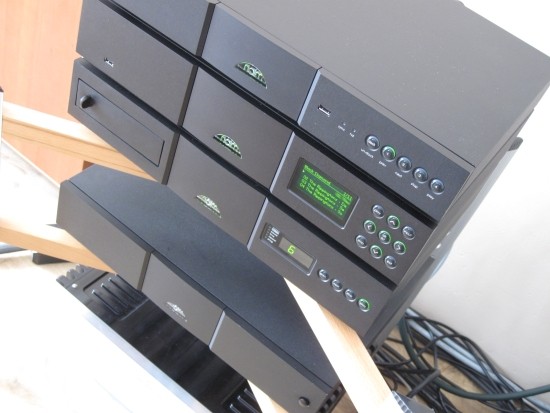
Placement was also an item. Normally I only review one component at a time, and compare it to my own equipment. This time it was a little bit more tricky. The first listening was with the CDX2 on top of the E&T imitation Spider rack and the NDX one level lower. When swapping their relative positions, it was clear that the top position sounded more open and cleaner/faster in the bass. Then I tried it with these two components stacked on top of each other but invariably the one at the bottom sounded fullest and the top one most airy, but lacking drive and slam. After lots of listening to the components in different places, I settled on the stacked variant, with the NDX on top. But for the final listening I moved my PS Audio PWD away from the real Spider rack and listened to the CDX2 and NDX, placed one after another, solely on the Spider’s top level. This made for the best sound. The difference between the Chinese fake rack and the real Finite item is in the details and dynamics: the real rack has a more nimble bass with more power and drive and also more transparency and slam in the midrange.
For the majority of the review I have used Cardas Hexlink cinch cables and swapped them over to other players and streamers for comparison. for the final assessments on the top level of the Spider rack however, I have also used Transparent Ultra XLR cables, and even with Cardas cinch-XLR adapters in the chain, this made for vastly better sound. It seems that the Naim components also don’t really like full and fat sounding interlinks. This all makes sense because typically Naim products are used with Chord cables, which are, in my limited experience, open and detailed sounding by nature.
My recent trend is to not spend too much time on describing functionality and technical properties, as they can be looked up easily elsewhere on the net, instead focussing more on the listening tests themselves, as that is what it is finally all about, the sound, isn’t it?
So far my story of the setup and the technical details, let’s move on to the listening impressions!
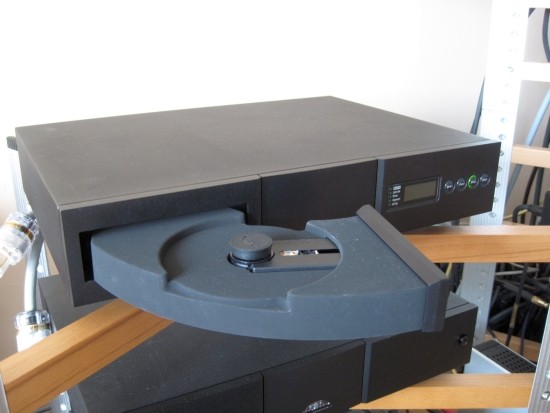
Listening – CDX2
The first component I tried was the CDX2. I was curious to find out how it sounded after a friend had had an original CDX for years and has always raved about it. As mentioned in the header, the Naim components under test here, have big power supplies and weigh quite a bit. The CDX2 is no exception: not only does it feel heavy, it also sounds that way: solid, dynamic, confident and with excellent bass that is at once deep, full, weighty and articulate. It carries great power and it is with its rhythmic qualities that the CDX2 impresses most.
The CDX2’s bass is different from that of Wadia, the other bass-champ: somewhat less cohesive and solid but similarly powerful and capable of a mighty kick. Moving all the way up the scale to the treble: in my reviews I always go on about fluidity. For me this is very important, especially because my Magnepan MG3.6R speakers are so revealing. Luckily the CDX2 doesn’t disappoint and shows quite fluid treble with enough air. However, the CDX2 is no smooth operator, and is less transparent and a little rougher than the Wadia S7i. Resolution isn’t its best feature. Play on low volume and there is the impression of missing some tiny details. Sounds don’t really carry on long, instead dropping to zero rather quick after the transient. Because of this, the CDX2 can sometimes sound dry. So, compared to the (double to triple price) Wadias and Levinsons, it can be a bit dry and cool, lacking some color and schmelz. But the CDX2 is just more about excitement, power, drive and foot-tapping involvement. And even if its soundstage can’t match the huge projection of the S7i and PWD, its overall presentation is nevertheless very intimate and direct, and because of that, highly engaging. A nice bonus is that less than stellar recordings still sound very enjoyable.
The bottom line for the CDX2 is that it is capable of conveying emotion easily, much more easily in fact than some technically superior components. In conclusion I wouldn’t classify the CDX2 as dry per se because with the right CD it can sound full and inviting and entirely satisfying. Play a little louder, and the music gains credibility and substance and the gaps seem to fill in slightly. So, even if it isn’t super-silky or very spacious, it is still a CD player that I wouldn’t mind having in the rack full time.
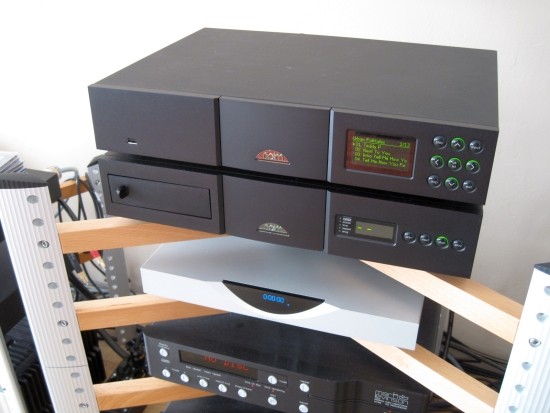
Listening – NDX
At first listen, the NDX sounds an awful lot like the CDX2. Same character in terms of detailing, openness, soundstage, speed, timbre… but wait… yes, indeed, there are some differences after all. The first thing I noticed after comparing the CDX2 with the NDX, was that the NDX sounded a little faster and more nimble, more nimble in the bass. It also sounded more detailed, and more fluid in the treble. But in spite of all these advances over the CDX2, I found it less colorful and less organic. Technically the NDX is superior, but emotionally somehow it lags behind the CD player. Maybe the CD player makes the music more beautiful than it is, maybe the streamer is too accurate, I don’t know. But of course these kinds of things can be all but compensated for. Remember: the initial comparisons were under identical conditions, but later I tried to get the maximum from each individual component and when I used Transparent Ultra interlinks instead of Cardas Hexlink, there was almost a sigh of relief, as now it sounded much more friendly, more emotional and much more engaging. Its natural character stayed present without diminishment, but gained some reality as well as a more organic, more emotionally appealing quality. The NDX still sounded fast, solid and lively, only now with a nice, fluid treble and a fuller tonality. In hindsight I thing that it now superseded the Uniti and Unitiqute units that I had over some months ago, by being much more solid and rhythmic and having fuller bass. Still, I remember those cuddly units to sound even sweeter, more refined and fluid throuh the treble. That must have been mostly down to the Echole powercord I used then, but have sold in the meantime. But the Furutech powercable I used now comes quite close really. Another factor is that in the meantime I have heard many more streamers, most notably the Linn Klimax DS/0. This one is so utterly smooth and refined, so highly resolved that any other streamer pales in comparison, on those aspects. Even my Levinsons cannot hold up in terms of low level resolution and treble fluidity. So yes, I may be a bit spoiled. The NDX has the same level-driven resolution behaviour in that it, too, sounds somewhat rough at low volume, but fills out nicely at higher levels.
The Linn Klimax DS/0 is a resident component and of course I compared it directly to the NDX. Well, that’s a diffcult comparison, because both components have a character all of their own and they are completely opposite: Naim has bigger, deeper, fuller bass and more drive, Linn has subtler, more refined treble, Naim has an acoustically-lively midrange, Linn has more color and a more natural timbre. I’d say they appeal to entirely different groups of people: the Linn for people who value precision, resolution, smoothness and refinement, the Naim for people who want to get moving and just want to dive in and get straight to it. In that sense it compares somewhat to the PS Audio PWD, which, like the NDX, also has boldness, liveliness and big bass and drive as its center capabilities. But the PWD goes a little further, especially in soundstage. Where the NDX (and the CDX2 alike) tend to have a narrow, but forward soundstage, the PWD has a 3D soundstage that fills the room to all borders and places musical instruments and voices neatly in their own positions within that stage, in many layers. The PWD is also even more dynamic and has even bigger bass. But it is also a little drier in the treble and really has to be tamed down with fat power cables and smooth interlinks.
On balance I find the PWD to sound better, but the NDX to be more reliable. For example, it connects straight away after plugging in the network cable. The PWD always needs some time and fiddling to recover. Not only is the NDX quick to boot up, it also remembers its position in the directory structure, even after a power cycle. So, if you were browsing your directory and went into a folder into a folder into a folder, and reboot, the NDX still remembers where you were and even restores the playlist. It’s things like this that are indicative of the attention that went into their design. The i-Device app is still the same as last time, that means still no search (scrubbing) within a track and no playlist functionality. But I hear that Naim is working on a super-version which should become available shortly.
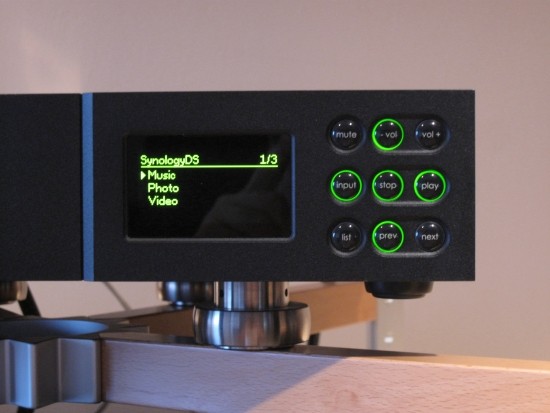
Above: only the keys associated with the current menu are active, indicated by green backlighting.
NDX niceties
Like the UnitiQute, the NDX is i-Device compatible and it has the same user friendly feature of being able to browse and play tracks from a connected iPhone with a wirelessly networked iPad. Or the other way around. Also, it extracts the signal digitally and with the NDX too, it sounds excellent, maybe even better than I remember the UnitiQute had sounded used that way. The i-Device connection ranks among the best I have heard, and that includes the Wadia 171i. Also, the NDX has several digital inputs, making it a very complete proposition.
XPS2 power supply
Then there’s the even heavier XPS2 power supply. This one is compatible with both the CDX2 and NDX, but naturally only powers one at a time. You’d think that the CDX2 and NDX already have such beefy power supplies, that surely they can’t change much more with an even beefier one. But you’d be wrong. Of course I knew that it does more than you expect because I have a bit of experience with Jeff Rowland and its BPS battery power supplies. But those are, as the name inplies, battery powered. Naim doesn’t do batteries, instead it does HUGE power transformers and multiple regulation stages. Several areas within NDX or CDX2 are fed individually regulated power lines. First we tried it on the CDX2 and the result was overwelming. First thing we noticed was the amount of color and substance added. Everything was harmonically much more fleshed out. No more dryness, at all. Bass became fatter and fuller, midrange more glorious and treble smoother and more fluid. Also, the soundstage grew considerably in all directions. Now here was a CD player that I could really live with. It now sounded truly highend. I already wanted it without XPS2 but as a combo this player really rocks.
Then we tried the XPS2 on the NDX. First impressions were similar to what we found with the CDX2: fuller, more substance, bigger bass… but somehow we now found it a less exciting listen, the NDX sounding less outgoing and even a little shut-in dynamically. In spite of the fuller tonality we found it to sound less natural. Also foot tapping was diminished with the introduction of the XPS2. So, we disconnected the XPS2 again and right away were confirmed in our suspicions: the NDX sounded more upbeat and lively, more engaging, without the NDX. With XPS2 the NDX sounded somewhat like the Levinson 390S cd player for tonality, but stayed behind for rhythmic swing and dynamics. Without XPS2 the NDX sounded somewhat like the PS Audio PWD, but it couldn’t match its soundstaging abilities.
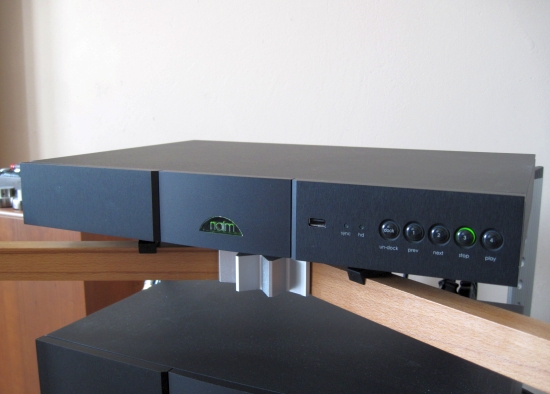
DAC swapping
Feeling somewhat dissatisfied with the results thus far, I connected the NDX digitally to the Levinson 360S DAC, without XPS2. This made for a different tonality: fuller, sweeter, more relaxed. Naturally I was hearing the typical Levinson strengths. But they were mixed in with what you could call the typical Naim strengths: power, drive, slam and attack. I also heard some of the NDX’s dryness throughout the frequency band, most prominent in the treble, which was slightly unpolished. I seem to recall that the Uniti and Unitiqute had sounded sweeter through this very same dac, but I might be wrong. Dryness aside, the NDX also managed to sound fuller in the bas and even more upbeat and dynamic than I recall the Uniti and Unitiqute to have been through the 360S. In fact: almost all the NDX’s dynamic constrained seemed gone. Well, it wasn’t entirely. It still didn’t really have much dynamic swing, but it was very lively and articulate. These combined aspects make the NDX stand in the opposite corner of the Meridian MC200 (review in progress) when it fed the Levinson DAC for the Meridian sounded much more mellow, fluid and refined, but also less articulate overall and less pronounced/projected through the midrange. But it turned out that the NDX’s excitement factor could be hightened even further.
It was time to test the Naim DAC. First partner up was of course the NDX. I again listened to it on its own and once again concluded that it wasn’t the most engaging listen. So, could the Naim DAC improve on this somewhat constrained quality? I didn’t want to take chances with fat-inducing cables so I connected it up with Belden RG59 coax cable with crimped on BNC connectors. Now here was a transformation! Bass tightened up considerably, becoming even a little too lean for my likes, but it was very rhythmic and articulate and it provided much better pace. Also the midrange snapped into focus, providing at once more dynamic realism and better low level resolution, taking this even further than with the 360S. Finally treble was also a little more refined, but basically possessing the same character as from the NDX itself. This is normal because that was also true through the 360S. Upon hearing these large differences, I wanted to eliminate any chance of accidentally listening to influences from these cables, so I swapped the powercords between NDX and DAC. They were the same brand and type of cable, but with slightly different connectors and I knew that one of the two sounded more mellow than the other. But even with the more mellow cable on the DAC, still that one sounded much more articulate, more lively and more dynamic, and because of that, more engaging and exciting. The DAC seems to have supreme PRAT, it makes your feet tap and you can’t stop them! This pairing was quite the team, sounding quite different from the components I normally use, but a very exciting listen.
The CDX2 showed advances in the same areas as the NDX when used with the DAC, but in this case I preferred the player without it. To my ears it simply sounds more human, more emotional, more organic by itself. The CDX2 is just very nicely balanced and doesn’t need much tweaking.
Just to see what would happen, I connected the NDX digitally to the PWD’s coaxial input and added the XPS2, making for a weird pairing. But the resultant sound blew my socks off! This was simply the best streamer sound of the evening! But it really is silly to use two streamers, no matter how good they sound when combined.
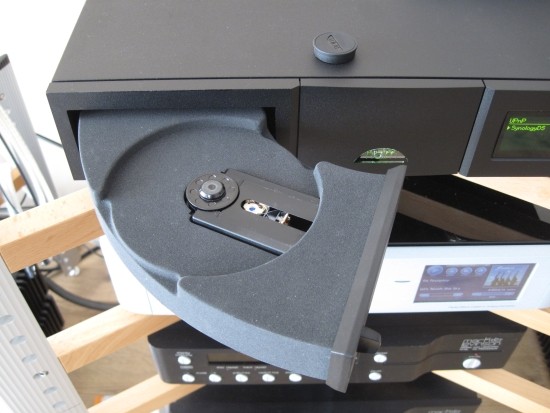
Naim DAC
Just to see what would happen, I connected the iPhone directly to the DAC. This sounded even more dynamic, more transparent too! But I did like the added color and fulness that the NDX provided with the iPhone connected to it. Unlike the NDX, which played nicely with an iPhone connected to its front connector, the DAC made funny crackling noised when I tried it. Plugging it into its rear connector (labelled ipod/iphone…) worked flawlessly however and produced great sound. A nice feature is that the four input buttons turn into transport controls for the i-Device.
I also tried the Naim DAC with the best CD players I have as transport: the Levinson 390S and the Marantz CD11LE. First up was the CD11LE with its CDM4MD swing arm mechanism. Prize-shot! The CD11’s sublime fluidity and swing combined fantastically with the Naim DAC’s sense of PRAT and articulation. This combo made sweet sweet music. Involving and exciting in equal measure. There was no constraints dynamically, rhythmically or otherwise. Also interesting: low level resolution and continuousness was now entirely up to scratch. I think I even like it more than the CDX2 by itself, but didn’t do a direct comparison.
Next up was the Levinson 390S. This was not a better match, the 390S reducing dynamics and dragging its feet rhythmically. But that isn’t surprising because I know that for some reason unknown to me, this CD player just doesn’t sound that good as a transport Even its recent overhaul, during which all its capacitors were changed, didn’t help it become a better transport. Used integrally however it is still my reference. I should just stop using it as a transport. Still, comparing the integrated 390S (with its built-in dac section) to the CD11LE combined with the Naim DAC makes for a tough decision. I like both. The Levinson has better soundstaging and room-filling abilities, as well as being king of bass. But the CD11LE+Naim DAC makes even more nimble sounds. Perhaps you could say that the Levinson is better for smoother music and the Naim DAC (with transport of choice) might be better for rhythm-driven music. But that’s pushing me to define preferences of which I’m not entirely sure. I just like both presentations.
Even though the Naim DAC isn’t my typical smooth and superfluid performer, I still massively enjoyed it because of its highly energetic and super positive sound. I’d say go against the Naim tradition and give it a big’n fat powercable, as well as some juicy sounding interlinks, and the result may be well beyond your wildest expectations. Heck, I was even surprised to like the DAC so much, fearing that I might find it too dry and sterile. Well, a tiny bit dry it may be, but it is far, far, far from sterile. Neutral, dynamic and accurate is more like it. In fact it reminds me of the PS Audio PWD for its enthusiasm and speed. It just doesn’t have its superb soundstaging or its solidity in the bass, nor the rich voluptuousness of the bigger Naim models, but this is definitely a splendid performer.
Chord Signature spdif interconnect
For the tests thus far I had used a Belden RG59 coax cable with crimped on BNC connectors, which has a nicely neutral, yet dynamic and lively character with excellent focus, drive and attack. When comparing to the same cable with cinch connectors and BNC adapters, you notice that the resultant sound is more “impressive”, with more presence in the treble and seemingly more attack. But you quickly realise that this makes the cable sound a bit agressive and unnatural. Switching to the cinch-terminated Chord Signature with BNC adapters at both ends reveals that even the BNC terminated Belden RG59 is a little rough around the edges and doesn’t have the best low level resolution. The Chord is much gentler and has sweeter treble with more nuance and refinement. But its sweet character is carried on throughout the frequency band, making for slightly attenuated mids and bass that has less drive. The more projected midrange of the Belden may well be an unnatural addition of the cable but it mated well with the Naim NDX and DAC. Then I tried the Chord into the cinch input of the DAC, leaving only one BNC adapter in the chain. And yes, immediately the bass improved, becoming bigger and more confident, and the midrange also benefited, becoming more natural and expansive. These tests once more prove that you should try to avoid adapters as much as possible. BNC is the better choice, but because most digital cables have cinch connectors, I think that Naim should have included a cinch output on the NDX too. Overall the Chord Signature is a very refined and friendly cable, but apart from the treble, I liked the BNC-BNC terminated Belden better for its more engaging sound and better PRAT, especially with these Naim components.

Conclusion
I like this Naim stack, I really do. But I’m a bit uncertain what to think of the NDX. Yes it is good, better than many a competitor in the streaming camp, and miles from popular streamers such as Squeezebox and Sonos or any computer based solution. But somehow, I can’t quite enjoy it as much as I did the Naim Uniti or even the Unitiqute. Could I be spoiled so much that I couldn’t enjoy anything less than state of the art? That’s a valid question to ask, but I’m inclined to disagree, based on listening to various players and streamers with very decent price tags. Also, listening to the CDX2 and the Naim DAC makes me think that the NDX is just a little different, having less soul and swing, less of an organic quality than I like. These results may be down largely to system synergy and personal taste, but for me, the NDX using its own built in DAC section simply fails to stir my soul. The CDX2 however is one heck of a CD player, injecting soul and expression into every CD that you care to load. It is organic, dynamic and engaging, and even if it likes to play a little louder in order to get a better sense of resolution and continuity, it is still a highly enjoyable listen. The CDX2 comes highly recommended and it makes me wonder how much more Naim can squeeze out of the CD format with their top players. The Naim DAC surprised me perhaps even more than the CDX2. The DAC, whether combined with an iPhone or fed from a good transport, simply never fails to excite with excellent dynamics, bass articulation and fine transparency and overall detailing. A great, neutral and dynamic, foot-tapping-inducing and highly musical DAC.
